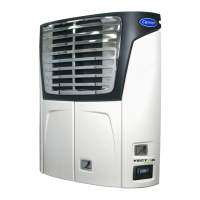7–25 62-11785
00075 COMP MOTOR OVERLOAD
• ACTIVATION: If alarm 00022 LOW SUCTION SUPERHEAT, 00027 HIGH SUCTION PRESSURE and/or
00028 CHECK REFRIGERATION SYSTEM was triggered with current below 5.5 amps. This alarm will
also trigger on restart from alarm 00022, 00027 and/or 00028 if compressor current does not rise above 1
amp, and alarm 00013 HIGH DISCHARGE PRESSURE is not active.
• UNIT CONTROL: Refrigeration system shutdown and alarm with PSCON still energized.
The compressor motor is fitted with an internal line break that may have caused this alarm. The line
break is an auto reset device. Additional time may be required to reduce winding temperature to the
reset temperature of this device.
• RESET CONDITION: Auto reset after 30 minutes alarm may be manually reset via keypad or by turning
the unit off, then back on again.
NOTE: Follow the steps below until a problem is found. Once a repair or correction has been made, the active
alarm should clear itself (refer to reset condition above). Operate the unit through the appropriate modes to see
if any active alarm occurs. Continue with the steps below as necessary.
CORRECTIVE ACTIONS:
1. Check For Alarms 00022, 00027 and/or 00028 (Check Download) - These alarms will always cause
this alarm to activate. Review steps for triggered alarms and correct if necessary.
2. Check Compressor Power Supply - Start unit and check voltage. Check current on each phase. Cur-
rent must be greater than 0 and less than 18 amps. (Compressor is operating.) If voltage is present and
current is 0, motor is overheated. Wait for compressor to cool for 30 minutes and check again. If voltage
and current are not present at load side of contact, check compressor contactor operation.
3. Check Compressor Motor Contactor - Check condition and wiring. Repair/replace as required.
4. Check Airflow Through Condenser Coil
a. Inspect condenser fins. Fins must be straight. 90% or more of the coil surface must be
undamaged. No “dead” air spaces. Coil must be clean (refer to Section 8.7.2).
b. Check condenser airflow. Even airflow through the entire coil. No “dead” spots.
c. Check condenser fan rotation/operation. Fans should operate correctly. Air drawn in through the
grill, and directed out properly.
5. Check System for Non-Condensables, Low Charge - Check refrigeration system for non-condensable
gas(es). No non-condensable gas(es) may be present. Refer to Section 8.5.2.
6. Perform Pretrip, Verify SMV and ECXV Functionality
Clear Active Alarm list, then run Pretrip & check for any new alarms. Any active alarms must be cor-
rected and cleared before proceeding.
7. Verify Accuracy of AC Current Sensor
a. Put microprocessor in PC Mode. Refer to Section 5.3.2. Must have 0 AC1 Amps and 0 AC2 Amps
in Unit Data.
b. Use a clamp-on ammeter to measure current draw of all 3 legs of the T side of PSCON/PSCON2.
Meter reading should be the same as Unit Data: Compare meter reading to Unit Data in PC Mode.
Compare meter reading to Unit Data with unit under load.
8. Check Compressor - Check compressor for excessive vibration or noise. Replace compressor. Refer to
Section 8.6.

